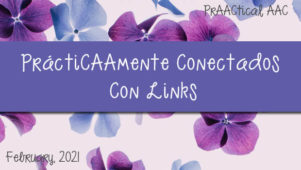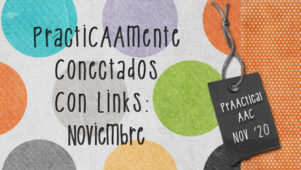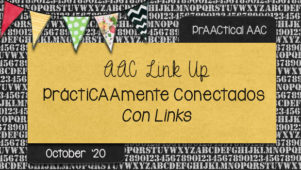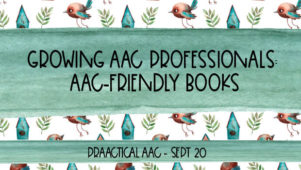How I Do It: Supporting Spanish-speaking AAC Learners
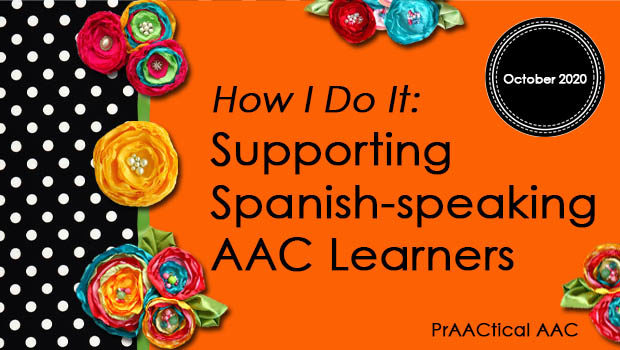
 We’ve been on a mission to add our support to the population of AAC users from Spanish-speaking communities, so when AAC SLP Deanna Wagner shared this piece she wrote on strengthening her Spanish language skills, we knew we wanted to share it. Here in the US, where speaking a second language isn’t as highly valued as it should be, many professionals struggle to become confident in languages other than English. In this post, Deanna shares her tips for strengthening her Spanish so that she can better serve the families she supports.
We’ve been on a mission to add our support to the population of AAC users from Spanish-speaking communities, so when AAC SLP Deanna Wagner shared this piece she wrote on strengthening her Spanish language skills, we knew we wanted to share it. Here in the US, where speaking a second language isn’t as highly valued as it should be, many professionals struggle to become confident in languages other than English. In this post, Deanna shares her tips for strengthening her Spanish so that she can better serve the families she supports.
In addition, she provides a helpful table of AAC apps that are available in Spanish that you won’t want to miss.
::::::::::::::::::::::::::::::::::::::::::::::::::::::::::::::::::::::::::::::::::::::::::::::::::::::::::::::::::
Building Spanish Language Skills
As an AT professional who supports families who speak Spanish at home, I am always looking for ways to brush up on my AAC vocabulary and Spanish terminology. I am not a native speaker, so I have a lot to learn!
Here are 5 ways I have built up my Spanish skills over the years:
Traveling and making friends in other countries. Immersion experiences really help us to feel confident that we are not just learning the words, but really figuring out how they work. This is a good lesson for people using AAC. Getting better at speaking the language through interactions with native speakers gives us both experiences and feedback. I have not always been great at this, but keeping in touch afterwards has also helped me to build my skills. I have shared my insecurities about social conversations with my travel companions and they now help me by chatting occasionally with me on Skype, Zoom, Facebook Messenger Live and WhatsApp.
Studying the programming menus to learn the technical words. My travel companions have not always been knowledgeable about AAC terminology. The best way for me to start learning this type of vocabulary was to switch the programming menus in the communication devices I was using (see table below). Even before iPads this was possible with the communication devices I was working with from Prentke Romich Company (now the Accent product line) and Dynavox (now using Snap Core First on TobiiDynavox devices). Now I do this regularly with all of the software and apps that I have. One thing I have noticed is that not all vendors have localized translations. So sometimes I will need to make modifications to match vocabulary that is used where I live. Sometimes families are unfamiliar with technical AAC vocabulary terms, and some prefer to learn/use programming menus in English. In the table below I will share some of my findings with regards to technical vendor translations. As bilingual English-Spanish communication apps are becoming more and more robust, I find that I can find more and more resources that have been translated to both languages (i.e., programming menus, manuals, quick starts, and help menus). I find it helpful to use 2 devices or to print and compare the documents in English and Spanish. I also added a Spanish keyboard to my iPhone and iPad, so I can take advantage of word prediction, completion and corrections localized to my area. Find steps to add another keyboard here.
Joining social media groups (like Facebook and Instagram), and looking for bilingual English/Spanish groups. I have found connecting with others on a social and professional basis to be extremely valuable. For example, in a recent post in the Bilingual Speech Language Pathologists Facebook group, we had over 30 comments to an inquiry about how bilingual therapists who are not native speakers can improve their Spanish. Some of my favorites included: watching slow news in Spanish, soap operas with captions turned on, switching the phone to Spanish language settings, asking for help at local Spanish-speaking businesses (ordering food, finding things in the store), taking a class (or hiring a tutor), and setting aside time to practice chatting with native speakers. Did you know that when somebody posts in another language Facebook provides an instant translation? The great thing about this is that you can decide to switch back to the original to compare how something might be said in both languages. I have encouraged some of my friends who speak Spanish to post comments on my posts in Spanish so I can work on my social commenting vocabulary, too. Snap Core First en Español is another Facebook group with about 4 posts per week. When we can check the average activity beforehand, it helps to make the decision about whether or not to join a private Facebook group.
Checking AAC vendor pages for translated content. Sometimes I change the search language on Google, and that helps me find information about implementation. I have found wonderful implementation resources in Spanish on the Saltillo Chat Corner, a few lesson plans/materials in Spanish on the AAC Language Labhttps://aaclanguagelab.com/lesson-plans, Assistiveware Spanish-language pulldown menus (for all of their blogs and most of the resources), and some materials on the TobiiDynavox pages in Spanish. I have searched for page sets in the Grid Explorer from SmartBox, but have found more pages localized for Spain than for my area.
Doing shared reading and other literacy activities using Spanish-language materials. I actually joined a shared reading group as a helper so I can practice listening to stories and songs for young AAC users. Using children’s books, songs and fingerplays are a great way to practice my Spanish. I have been exploring the Year of Core words in English and looking for versions of stories that are either in Spanish or bilingual. There are a few. A great example is The Mitton (El Mitón) by Jan Brett. YouTube has some great options for songs and stories for learning Spanish. YouTube has settings to add captions and slow down the speed. When importing YouTube videos into Google Slides or EdPuzzle I can decide where to start and stop the videos to practice finding the words in an AAC system. I really love Super Simple Songs, and they have been translated so that way I get the opportunity to use a familiar tune with new words.
Table of Communication Apps
| App | Programming Menus Automatically | Menu language can be switched | Translated help menus and guides | Core is consistently located (motor plan) | Category words are consistently located | Robust AAC |
| GoTalk NOW+ | Y | N | Y | n/a | n/a | Limited vocabularies pre-programmed in English. Add your own Spanish pages |
| Grid for iPad | Y | N | Y | most | N | Core, Category & Spelling in English and Spanish (Spain) |
| LAMP WFL | Y | N | Y | Y | Y | Core, Category & Spelling in English and Spanish (Latinamerican) |
| NuVoice on Accent | N | Y | Y | Y | Y | Core, category, some phrases, & spelling with Unidad (localized icons) |
| Proloquo2go | Y | Y | Most | Some | Core, Category & Spelling in English and Spanish (Latin American option) | |
| Proloquo4text | Y | Y | n/a | n/a | Spelling-based app with phrase support | |
| Snap Core First | N | Y | Most | Yes – organized by English order (alphabetized) | Core, category, phrases & spelling | |
| Snap Scene | Y | N | Y | n/a | n/a | No – only recorded |
| Sounding Board | Y | N | Y | n/a | n/a | No – only recorded |
About the Guest Author
Deanna is an AAC SLP based in Phoenix, Arizona. You can learn more about her here. She also heads up a PrAACtical AAC initiative, Hablando PráctiCAAmente, coordinating the activities of dozens of AAC parents and professionals around the world to create high-quality translations of our content into Spanish. Stay tuned for more information about that project later this fall.
Filed under: Featured Posts, PrAACtical Thinking
Tagged With: Bilingual AAC & Multilingualism, Spanish, Therapist & Therapy
This post was written by Carole Zangari

